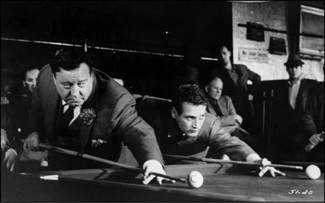|
|
Current Issue
Previous Page Page 3 Next Page
Untold Stories: The Legacy of The Hustler

|
| Gleason (left) required little instruction, while Newman needed a crash course. |
Paul Newman staggers forward, arms outstretched. "Fats," he pleads. "Fats... you can't quit me!" The stink of failure clings to Newman like day-old sweat. He's exhausted, and he's pathetic, and he begs, he begs. ... "You can't run out on me, Fats. C'mon. I got $200 here. C'mon." And that's when it happens: Newman topples forward; he hits the floor-but hard. There's that loud thump. Blam! The balding Myron McCormick rushes over. Jackie Gleason is there, too, but he exhibits not the slightest trace of compassion. The fat actor straightens his overcoat after a moment and then walks away.
Other than the hollow tap-tap of Fats's well-shined shoes, no sound disturbs the scene. It's a brutalizing horrible silence, and it suffocates everyone and everything in the dingy poolroom.
A second passes during which the actor does not stir. It seems as if he might have actually injured himself.
Another second. Newman remains prone.
Another second.
And then, finally ... "Let's do it again, Robert." The actor jumps to his feet but does not dust off his pants. There's that million-dollar smile. "One more time, Robert. I don't think that was it." Paul Newman is ready to go.
One-flight-up on West 44th Street in Manhattan (and smack-dab center in the middle of this industry-wide plague), the 53-year-old director had created the sort of poor man's club that Cy Kalmet had warned about. The poolroom was Ames, but Rossen had changed it to look more like Chicago's Bensinger's. The director spent $20,000 jointing up the New York room, giving it an exhausted feel. He even went to Chicago specifically to see Bensinger's, which was one of the last of the nation's old-time poolrooms, and he copied some of the tournament posters hanging there. He also ordered a fresh coat of cracked paint for Ames, and the crew installed one sign that said "Please do not spit on the floor" and another instructing patrons that both gambling and minors would not be tolerated. Rossen replaced good chairs with rows of decrepit ones and somewhere found a knee-high spittoon.
Gleason, no stranger to poolhalls, said it was important to create an atmosphere that comported with Americans' expectations of the game. "Poolrooms usually assume a dirty antiseptic look," he said between takes. "[There are] spots on the floor, toilets stuffed up, but the tables are brushed immaculately-like green jewels lying in the mud." It was also precisely the sort of image that the industry was attempting to run away from.
"The Hustler" was based rather faithfully on a 1959 novel by Walter Tevis, which he wrote as part of his University of Iowa master's thesis, and which he based on his observations of poolhalls in his native San Francisco and Lexington, Kentucky. Although the public was indifferent and the book at first sold fewer than 6,000 copies for HarperCollins, Hollywood saw promise. Within a week of publication, Tevis had offers from five separate studios.
"When I was 11, my closest friend had a pool table in his basement, and I became a pretty good player," he explained. "Also, when I was a student at the University of Kentucky in Lexington, the best job I could get to help support me through college was at a poolhall at night. I worked there for about a year and a half. I met a number of pool hustlers, and in a writer's cynical way I cultivated their acquaintance, thinking I might use them for material sometime."
Twentieth-Century Fox hired Newman for the Fast Eddie character and Gleason for Fats. Director Rossen did almost all of the camera work on location in New York City - either at newly dirtied-up Ames or over at McGirr's, which had recently switched from a location on Broadway to newer digs at Forty-fifth Street. There was also a midtown Greyhound bus station and an Eighth Avenue bar and grill. Besides powerhouse actors Gleason, Newman, and George C. Scott, the film featured the delightfully frail Piper Laurie and a cameo appearance by the retired boxer Jake LaMotta, who played a gruff bartender.
The director contacted Mosconi during an exhibition at Julian's and explained that he needed help in setting up shots and training actors. Willie has said variously that he was offered a flat $10,000 fee for the film or $833 a week for four weeks. He did not say yes to Rossen immediately, but he did say yes eventually.
Previous Page Page 3 Next Page
Top |
|





